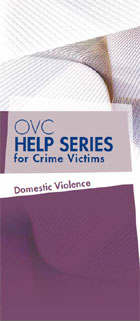 The Facts About Domestic Violence
The Facts About Domestic Violence
Intimate partner violence made up 22 percent of the violent crimes against women and 5 percent of the violent crimes against men in 2010.1
In 2010, 407,700 women and 101,530 men were victimized by an intimate partner.2
In 2010, 37.5 percent of all female murder victims were killed by a current or former spouse or boyfriend.3
From 2001 to 2005, one-half of female intimate partner violence victims were physically injured and 18.5 percent were treated for their injury.4
Approximately one in three adolescent girls in the United States is a victim of physical, emotional, or verbal abuse from a dating partner.5
During 2008, the National Coalition of Anti-Violence Programs documented 3,419 cases of lesbian, gay, bisexual, and transgender domestic violence victimization, 9 of which resulted in murder.6
In 2008, 1 in 10 children under the age of 18 (9.8%) had witnessed one family member assault another; 1 in 5 (20.3%) reported witnessing a family assault sometime during their lifetime.7
Domestic violence is a term that covers many types of acts committed by a current or former intimate partner against another, or within a family. It can take the form of physical violence, sexual abuse, emotional or psychological abuse, financial abuse, or other controlling behavior. It can include threats, such as threatening to commit suicide or take the children away from the victim. Victims of domestic violence can be of any age, racial or cultural background, education level, financial level, religion, gender, or sexual orientation.
Domestic violence is usually not a single event and often becomes more severe and frequent over time. Many batterers are not violent in other relationships, such as at work or with friends. They routinely deny that the abuse occurred, minimize its severity, or blame the victim for the abuse.
Many factors contribute to domestic violence and abusive behavior—abusive family background, feelings of inadequacy, and stress. But ultimately it is driven by an abuser’s need for power and control. Being drunk or high may intensify existing violent behaviors, but alcohol or drug abuse does not cause domestic violence. Regardless of the underlying factors, the batterer is responsible for his or her actions—not the victim.
Domestic violence affects not only the direct victim, but also those who witness it. Children are particularly affected: those living with family violence are more likely to have problems with anxiety, self-esteem, depression, anger, and temperament.
The most difficult step for you to take is to admit that you are being or have been abused by your partner. Remember, your partner’s violence is the problem, not you. You do not provoke it. You do not deserve it.
The physical and emotional suffering you experience may have long- and short-term effects. The suffering may seem to use up all of your energy. You may feel trapped, alone, and that you have lost control of your life. You may question yourself and your reactions. Regardless of your reactions, it is important to remember that every victim is different, as is every response to domestic violence. The reactions you are having to your abuse are normal.
Your safety is the first priority. Every person in an abusive relationship should have a safety plan—concrete steps you can take to stay safe or to get to a safe place if you or your family is in danger. Domestic violence shelters and advocates in your community can help you develop a safety plan that is tailored for your individual situation. The people closest to you can be part of your safety plan. Let trusted friends and family members know about your situation, unless doing so will endanger you in any way. Know where to get help. Tell someone what is happening to you.
Remember, as a domestic violence victim, you are not alone. Do not lose hope.
A domestic violence advocate can help you learn about your rights as a victim of domestic violence and provide you with information about your legal options, such as reporting the crime to local law enforcement or obtaining a protective order. An advocate can also connect you with your local women’s center, shelter, or domestic violence program, which can be another important resource for emotional support, shelter, or financial assistance. Local police, hospitals, churches, family or conciliation courts, crisis intervention services, or departments of health and human services can also give you information about local resources.
All states have crime victim compensation programs that reimburse victims for certain out-of-pocket expenses, including medical expenses, lost wages, and other financial needs considered reasonable. To be eligible, you must report the crime to the police and cooperate with the criminal justice system. Victim assistance programs in your community can give you more information about applying.
It is important to remember that the abuser is the only one who can change his or her violent behavior. Many communities have batterers’ programs, which try to help abusers learn how to control or change their behavior. Participation in these programs is often a court-ordered condition when batterers are convicted of domestic violence charges.
Whatever type of domestic violence situation you are in, resources are available to you. You deserve help. You deserve support. You deserve to feel safe.
National Domestic Violence Hotline
1-800-799-SAFE or 1-800-799-7233
1-800-787-3224 (TTY)
www.thehotline.org
National Coalition Against Domestic Violence
303-839-1852
www.ncadv.org
National Center for Victims of Crime
202-467-8700
www.ncvc.org